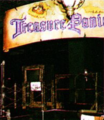Treasure Panic
From Sega Retro

| |||||||||

| |||||||||
| Treasure Panic | |||||||||
|---|---|---|---|---|---|---|---|---|---|
| System(s): Large attraction | |||||||||
| Publisher: Sega Enterprises, Ltd. | |||||||||
| Genre: Action | |||||||||
| Number of players: 32 | |||||||||
|
Treasure Panic (トレジャーパニック) was a redeveloped version of Ghost Hunters, and was first (and only) seen at Tokyo Joypolis on the center's opening day on July 1996 as one of nine debuting rides[2]. Its location in the facility was adjacent to its "MYSTERIOUS" area, neighbouring other newer horror-themed attractions, including Beast in Darkness and The Crypt[3].
Though the physical attraction itself remains the much the same as Ghost Hunters, with the exception of the additions of a branching path and different theming, its revised gameplay concept revolves around submerged treasure on a sunken pirate ship; players' guns instead act as triggers for large gloves used to hit and grab ghost pirate opponents[3].
The ride was removed from the park around late-2000 to make way for the park's remodelling phase.
Shinjuku Joypolis' Ghost Hunters installation is also reportedly planned to have been upgraded to Treasure Panic, however this is not thought to have occured[4].
Locations
| Venue | Opened | Closed |
|---|---|---|
| Tokyo Joypolis (5F) | 1996-07-12[1] | 200x |
Magazine articles
- Main article: Treasure Panic/Magazine articles.
Photo gallery
References
- ↑ Jump up to: 1.0 1.1 http://www.sega.co.jp:80/sega/atp/atc/treasurep.html (Wayback Machine: 2000-06-11 16:30)
- ↑ http://www.sega.co.jp/sega/atp/tokyo/panic.html (Wayback Machine: 1996-12-24 11:02)
- ↑ Jump up to: 3.0 3.1 http://www.sega.co.jp/sega/atp/tokyo/mystery.html (Wayback Machine: 1996-12-24 10:58)
- ↑ Sega Magazine, "1997-03 (1997-03)" (JP; 1997-02-13), page 23
| CollapseTokyo Joypolis | |
|---|---|
|
| |



